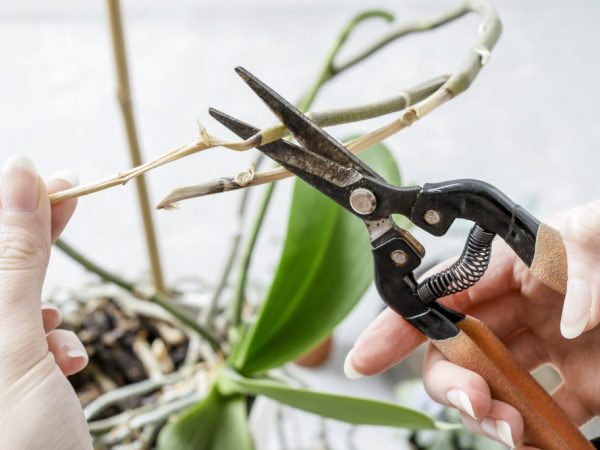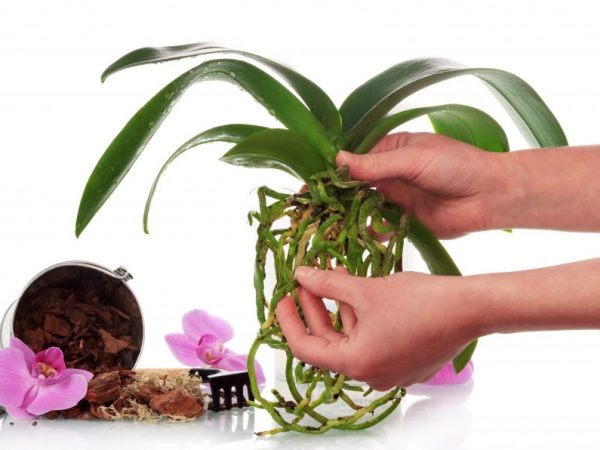Pruning an orchid after flowering
When there are no flowers or buds left on the plant, it goes into a dormant state. Culture is allowed to rest. Pruning your orchid after flowering at home is an important step in your care. The procedure is carried out taking into account the variety of the plant. When buying a flower, you should check with a consultant how to apply the procedure to a specific species.

Pruning an orchid after flowering
The need for pruning
Florists often wonder whether it is necessary to cut the peduncle of a faded orchid. Opinions are divided on this. Proponents of different points of view are right in their own way.
This is explained by the fact that representatives of one group of orchids must be cut off, otherwise they will not bloom again. For a number of other species, pruning at home is done at your discretion, paying attention to the condition of the plant.
When to prune
The culture blooms from 2 to 6 months, sometimes several times a year, depending on the variety. For many of them, the completion of the flowering stage is determined by the changed color of the peduncle - it acquires a waxy shade. For the phalaenopsis orchid, pruning is carried out in the autumn months - October or November.
It is worth considering that some members of the orchid family bloom again. Therefore, make sure that the plant does not enter the flowering phase again. For this, the culture is left alone for a while. If the peduncle dries out completely, the procedure is started. In many species, it is performed when the stems acquire a brown tint.
You should also know when to prune the phalaenopsis orchid. Some growers do this immediately when it has faded. Then the culture will quickly please with new flowers. After manipulation, arrows will begin to form from the additional dormant buds that are located on the shoot. The peduncle of this variety remains green for a long time. If it is not removed, the shoots will begin to grow. The branches will stretch too far. It will become difficult for a culture to cope with such dimensions.

For the phalaenopsis orchid, pruning is carried out in the fall
Peduncle pruning for orchids of other varieties is not performed if:
- The needle is not completely dry. The plant receives nutrients with its help. If the organ is removed at this stage, the culture will spend a lot of energy on recovery. The next flowering will come no earlier than six months later.
- There are buds on the arrow or its tip is green. In this case, you should wait. The plant can bloom again. Phalaenopsis is distinguished by this feature. Although some growers are of the opinion about the need for circumcision, this will provide him with rest.
Required inventory
To properly prune the orchid after flowering, choose the appropriate tools. For manipulation you will need:
- garden pruning shears - the most suitable tool, does not leave burrs, while scissors or a knife can damage the leaves;
- disinfectant - they treat the instrument, as well as the cut sites, to prevent the infection of the culture with diseases;
- gloves - tissue juice often causes skin burns.
Pruning shears can also be disinfected by keeping it in boiling water for a few minutes. Some growers soak the tool in a bleach solution.
Pruning rules
To save the power of culture for the formation of young shoots in the future, only the sluggish part of the stem is removed. The peduncle of an orchid should be cut using the following methods:
- It is shortened at a distance of 1.5 cm from the sleeping kidney. The use of this method poses a certain risk. After removing the old stem, the growth of new ones sometimes slows down. The reason is that culture directs forces to the development of formed kidneys.
- Cut the branch at the outlet, the remaining branch should be 2.5-3 cm long.
It is worth cutting off a faded orchid with extreme caution so as not to harm it. If several shoots depart from the peduncle, then the part that has dried up is removed. For processing the sections, crushed activated carbon, iodine, brilliant green are used. If, during cutting, it is found that the stem is hollow inside, it should be covered with beeswax. Otherwise, when watering, water will get into it. This will provoke rotting of the organ of culture. The disease after a while affects her entirely. Thanks to such manipulations, pests will not be able to penetrate inside.

Cut off a faded orchid very carefully.
It is also worth trimming the leaves of the orchid. This will help her move into a state of rest. In some species, babies appear after the flowering period. Then they wait until they take root and have well-developed leaves. After that, they are cut off, capturing a small part of the peduncle. The cut is processed, the baby is planted.
In the orchid, the lower leaves are also cut off. If the culture is overloaded with green mass, then it will not be able to bloom in the future. Yellowed, dried leaves are also not beneficial. The procedure is performed step by step:
- cut the edge along the central vein;
- ripped to the trunk;
- carefully removed.
Care after pruning
The orchid after pruning requires proper care, since the procedure is stressful for it. Therefore, the plant is left alone for a while. If a culture goes into hibernation, then it must be looked after accordingly. For most species, this period lasts about 2 months.
Reduce watering. Water is added in moderation. The soil mixture should dry out between humidifications. Ventilate the premises. Culture does not tolerate drafts. If the air is too dry, it is humidified using special devices. The temperature should be 12 ° C-18 ° C, depending on the species. Top dressing is stopped. Provide good illumination.
If the orchid was cut in the summer, then it is shaded. The plant is protected from direct sunlight with curtains or a matte film, which is fixed to the window.
After trimming the lower leaves, watering is not done for several days in order to heal the wounds. Sometimes the green leaves become lethargic. In that case, it's worth the wait. They often acquire more elasticity. But if they start to dry out, the leaves should be cut off.
In some cases, the flower should be transplanted. During the procedure, the roots are examined. If rotten or dry are found, they should be cut off.
When the end of the dormant period approaches, they stimulate the conception of new flowers. This is achieved through temperature changes. The difference between the indicators during the day and at night should be 7 ° C. Such manipulations contribute to the ejection of the flower arrow.
Conclusion
To know how and when to prune orchids, you should carefully study the requirements and characteristics of the species. The procedure is one of the stages of care, the correct application of which promotes flowering.
Pruning the plant must be done with extreme care. After that, he is provided with rest, and then appropriate care. Then the flower will delight you with a healthy and beautiful look.


